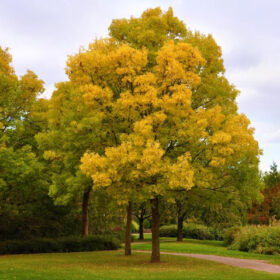IDENTIFICATION
Scientific name:
Fraxinus excelsior

Italian common name:
Frassino maggiore o frassino comune, Noce selvatica, Oga, Juorno, Fersena, Muddia sarvaggia.
Family:
Oleaceae
Origin:
Europe, Türkiye and the Caucasus
Environment:
Temperate and subtropical regions of the Northern Hemisphere, but also tropical ones such as Mexico, Cuba, Java and the Philippines
Evergreen or deciduous:
deciduous

Toxicity:
not
PLANT RECOGNITION
Height:
from 8 to 20 m, it can exceptionally reach 40 m
Width (extension):
up to 15 m
Habit:
large tree, slender and majestic
Leaf:
large, deciduous compound imparipinnate formed by 4-7 pairs of opposite and minutely serrated sessile leaflets, dark green and shiny on the upper surface, lighter on the lower one
Flower:
hermaphrodites, they are gathered in panicle-shaped axillary inflorescences and are small, greenish in color and appear before the leaves; they have no calyx and corolla with very short stamens surmounted by a dark purple globose anther
Flowering:
March – May
Fruit:
oblong samaras of variable shape with rounded or truncated base, with a single seed, gathered in hanging clusters.
Trunk:
straight and cylindrical with bark that is initially smooth and olive, then grey-brownish and cracked longitudinally
Property:
tree with medicinal and officinal properties. The dried leaves, bark and seeds contain substances with febrifugal properties (due to the presence of a glucoside, ash) and astringent, but also tonic, laxative and sudorific properties. In folk medicine the leaves are used as a light diuretic, in case of rheumatism and gout. Manna is extracted from the sap that comes out of the wounds, a substance also used as a sweetener with laxative properties suitable for children, the elderly and diabetics. A “good for everything” herbal tea is prepared from it and is used by the greatest phytotherapists due to its numerous health-promoting properties (Chiereghin).
For further information go to this link: erbeofficinali.org
Parfume:
not
NEED
Maintenance:
Medium maintenance requirements: requires high quantities of irrigation and a continuous and timely fight against parasites until liberation. The thin bark is easily damaged by vandalism or mechanical impacts – such as motorized lawnmowers.
Light Exposure:
full sun, but quite shade tolerant in the juvenile phase
Soil type:
Adaptable: Clay, Sand, Loam, Gypsum, Sandy soil. Prefers deep, fresh, not dry soil
Soil acidity:
Adaptable pH 5.0 – 8.5 Moderately acidic, Slightly acidic, Neutral, Alkaline
Italian climatic area:
Species present throughout Italy, especially in the North, up to around 1,200 m above sea level. It is also present in fresh gorge woods in central and southern Italy
Need for water:
Young specimens must be irrigated while for adult plants it is normally not necessary to intervene, however, when there are periods of prolonged drought it may be necessary.
Propagation:
by seed
Pruning:
rarely necessary, only in the case of young specimens to correct any bifurcations, and therefore to obtain a single trunk.
Diseases:
Cantaride, Ciono, Ilesino, Sawfly, Wood decay, Rot of seedlings, Powdery mildew or White disease and the new fungal species Chalara fraxinea of which we attach a PDF for further information.
PARTICULARITY 
the name Fraxinus has an uncertain origin. In fact, according to some it derives from the Latin “frango” which means to bend in relation to the high flexibility of its wood. According to others, it derives from the Greek “fraxis” which means separation, because it is a plant that was planted as a property boundary signal. Mattioli said of this plant that it was so hostile “that no snake ever came towards it”. Excelsior refers to the grandeur of the plant, which reaches up to 40 meters in height.
Annotations

The species in this group generally have rapid growth, managing to survive in difficult environmental conditions such as polluted areas, with salt or strong winds, resisting well even at low or high temperatures.
In the Nordic countries, the Ash tree was worshiped as a sacred plant, Odin, the greatest of the Nordic gods, created the first man on earth with Ash wood. Burning ash wood was commonly believed to ward off evil spirits. In the regions of northern Europe it has mythical value; It attracted attention above all for its wood, from which excellent weapons were obtained, and for its foliage, used as fodder. The Greeks and Romans already clearly distinguished the two species, one made of earth and the other made of rock, from the more compact wood. Hippocrates (5th century BC) and Theophrastus (1st century AD) recommended the leaves as a diuretic, laxative and antirheumatic. Saint Hildegard recommended it as an anti-gout. It is the subject of various popular traditions: generally its wood is used to make walking sticks, because it is believed to be able to ward off snakes; another legend claims that to celebrate the birth of a child, an ash tree dedicated to him must be planted and when he grows up he will have an honest life and a healthy and robust body.
In relationships with fungi, it is the preferential mycorrhizal partner of morels in general.
They can be used as unique specimens, or to create woods, to tree avenues, as windbreak screens and to consolidate slopes. It is a plant much appreciated for its shape, which is very regular and pleasant; furthermore, the yellow color of the foliage in autumn also makes it appreciable from a chromatic point of view.
In the kitchen:
Buds: in salads, leaves: in infusions as a drink
THE MONDO DEL GIARDINO ADVICE
Despite being a large tree, it does not have a very dense foliage and can therefore be used, in a large plot, in the background to cover something without completely blocking the view.
Now on horseback! Work awaits us! Our new wonderful outdoor space is about to be born!
GOOD WORK and…if you have any questions, write to info@ilmondodelgiardino.com
Image sources: thanks to Pixabay and many thanks to Ramon Perucho for the photo for social media and WikimediaImages for the cover and below WikimediaImages, Hans, Manfred Richter, Rupert Kittinger, Wyxina Tresse, actaplantarum.org, zinipiante.it, universoalpino.com and unalberoalgiorno.blog for the closing photo.



